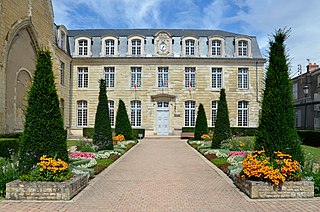Poitou is a former and historical province of France.
Contents
Poitou may also refer to:
Poitou is a former and historical province of France.
Poitou may also refer to:

Poitiers is a city on the river Clain in west-central France. It is a commune and the capital of the Vienne department and the historical centre of Poitou. In 2021 it had a population of 90,240. Its conurbation had 134,397 inhabitants in 2021 and is the center of an urban area of 281,789 inhabitants. It is a city of art and history, still known as "Ville aux cent clochers".

Poitou was a province of west-central France whose capital city was Poitiers. Both Poitou and Poitiers are named after the Pictones Gallic tribe.

Deux-Sèvres is a French department. Deux-Sèvres literally means "two Sèvres": the Sèvre Nantaise and the Sèvre Niortaise are two rivers which have their sources in the department. It had a population of 374,878 in 2019.
Poitevin may refer to:

Poitou-Charentes was an administrative region on the southwest coast of France. It is part of the new region Nouvelle-Aquitaine. It comprised four departments: Charente, Charente-Maritime, Deux-Sèvres and Vienne. It included the historical provinces of Angoumois, Aunis, Saintonge and Poitou.
Ebalus, or Ebles Manzer, or Manser, was Count of Poitou and Duke of Aquitaine on two occasions: from 890 to 892; and then from 902 until his death in 935 (Poitou) and from 928 until 932 (Aquitaine).
William III, called Towhead from the colour of his hair, was the "Count of the Duchy of Aquitaine" from 959 and Duke of Aquitaine from 962 to his death. He was also the Count of Poitou from 935 and Count of Auvergne from 950. The primary sources for his reign are Ademar of Chabannes, Dudo of Saint-Quentin, and William of Jumièges.

Châtellerault is a commune in the Vienne department in the Nouvelle-Aquitaine region in France. It is located in the northeast of the former province Poitou, and the residents are called Châtelleraudais.

The Saintonge War was a feudal dynastic conflict that occurred between 1242 and 1243. It opposed Capetian forces supportive of King Louis IX's brother Alphonse, Count of Poitiers and those of Hugh X of Lusignan, Raymond VII of Toulouse and Henry III of England. The latter hoped to regain the Angevin possessions lost during his father's reign. Saintonge is the region around Saintes in the centre-west of France and is the place where most of fighting occurred.

The Battle of Taillebourg, a major medieval battle fought in July 1242, was the decisive engagement of the Saintonge War. It pitted a French Capetian army under the command of King Louis IX, also known as Saint Louis, and his younger brother Alphonse of Poitiers, against forces led by King Henry III of England, his brother Richard of Cornwall and their stepfather Hugh X of Lusignan.
Emenon was the Count of Poitou (828–839), Périgord (863–866), and Angoulême (863–866).

The Poitevin or Poitou is a French breed of draft horse. It is named for its area of origin, the former province of Poitou in west-central France, now a part of the region of Nouvelle-Aquitaine. It was formed in the seventeenth century when horses of Flemish or Dutch origin, brought to the area by engineers working to drain the Marais Poitevin, interbred with local horses. Although it has the size and conformation of a draft horse, the Poitevin has never been bred for draft abilities, and has been little used for draft work. Its principal traditional use was the production of mules. Poitevin mares were put to jacks of the large Baudet du Poitou breed of donkey; the resulting Poitevin mules were in demand for agricultural and other work in many parts of the world, including Russia and the United States. In the early twentieth century there were some 50,000 brood mares producing between 18,000 and 20,000 mules per year.
Asnières-sur-Blour is a commune in the Vienne department in the Nouvelle-Aquitaine region in western France. The commune has 180 inhabitants (2019).

Neuville-de-Poitou is a commune in the Vienne department in the Nouvelle-Aquitaine region in western France.

The Baudet du Poitou, also called the Poitevin or Poitou donkey, is a French breed of donkey. It is one of the largest breeds, and jacks were bred to mares of the Poitevin horse breed to produce Poitevin mules, which were formerly in worldwide demand for agricultural and other work. The Baudet has a distinctive coat, which hangs in long, ungroomed locks or cadenettes.

Vienne is a landlocked department in the French region of Nouvelle-Aquitaine. It takes its name from the river Vienne. It had a population of 438,435 in 2019.
The term mammoth donkey or mammoth jack is both an informal term for a large male donkey and a term sometimes applied generically to some specific large donkey breeds or landraces.

Nouvelle-Aquitaine is the largest administrative region in France by area, spanning the west and southwest of Metropolitan France. The region was created in 2014 by the merging of Aquitaine, Limousin, and Poitou-Charentes in a territorial reform. Nouvelle-Aquitaine has an area of 84,035.7 km2 (32,446.4 sq mi) – more than 1⁄7 of Metropolitan France – and has a population of 6,033,952 as of 2020. The new region was established on 1 January 2016, following the regional elections in December 2015.

The Poitevin mule or French: mule Poitevine is a type of large mule from the former province of Poitou in western central France. It is the product of mating between a Baudet du Poitou jack or donkey stallion with a mare of the Poitevin Mulassier breed of draught horse. Mule production was an important industry in Poitou for three hundred years or more, and the number of mule foal births may have reached 30,000 per year. In the early twentieth century there were about 50,000 Poitevin Mulassier brood mares, which gave birth to some 18,000–20,000 mule foals per year.
Poitiers is a city in France.